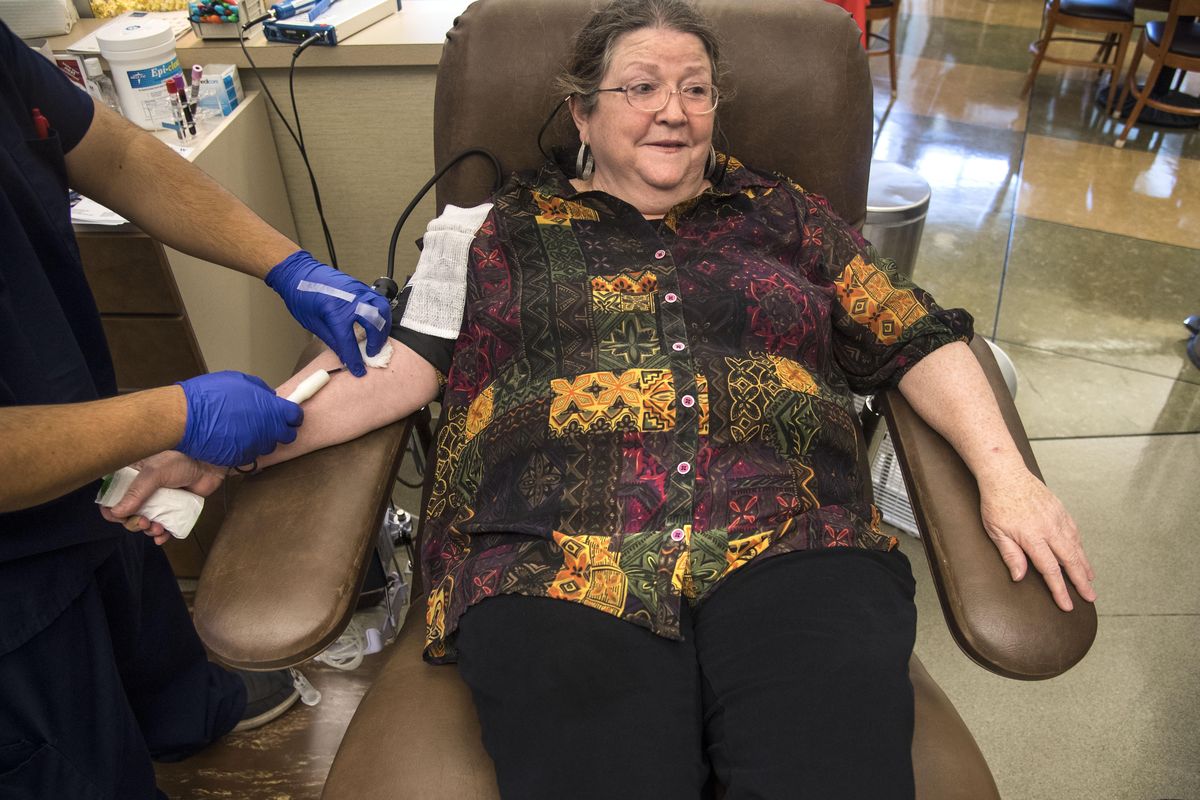Blood donations needed to alleviate shortages during disasters such as Hurricane Harvey

Mary Ann Carey used to donate blood three times a year, but after retiring, she’s been less regular.
“I haven’t been getting the emails nagging me,” she joked.
But she made it back to the Inland Northwest Blood Center on Thursday after seeing on the news that the center needed donors to send extra blood to Houston in the wake of Hurricane Harvey.
INBC shipped 197 units of blood to Texas earlier this week, and has committed to sending additional platelets to the area as well.
Carey’s mother was a nurse who donated until she was 93, so she feels keeping up the tradition is a family obligation. Doubly so, she said, because many of her relatives are afraid of needles and refuse to come in.
Plus, there are good snacks.
“Little Debbie snacks are an incentive,” she said. (A staff member points out a donation burns about 600 calories.)
The call for blood donors during natural disasters is typical, but people may not always know what happens to their blood after they donate or why it’s needed.
In some cases, disasters dramatically increase the need for blood because hospitals are seeing more trauma patients who need transfusions. But even in events like Harvey, where trauma is less common, blood is still needed.
That’s because most donated blood is used in more routine procedures: during surgeries, and for patients with cancer or sickle cell anemia who need regular transfusions as part of their treatment.
Even with much of Houston underwater, patients in hospitals still need blood for necessary surgeries and other scheduled, life-saving treatments that can’t be delayed. But when a city is underwater, blood drives get canceled. In the case of Houston, the donor cancellations put cancer patients in a lurch.
“Donating blood isn’t going to be top of your mind when your house is flooded,” said Tesia Hummer, a spokeswoman for INBC.
The blood itself isn’t delivered to hospitals in the one-pint bags many people think of when they donate. Instead, the pint of blood goes to INBC’s lab at their main facility on Cataldo Avenue, where it’s spun by centrifuge to separate plasma from red blood cells.
Each donor has a few test tubes of blood taken out separately during the donation that are flown to a lab in Arizona first thing the following morning. Samples go through a battery of tests for HIV, West Nile virus, hepatitis B and C and more, and INBC gets results about 36 hours after donation. Only then can it be released.
Some of the tests are done in batches, which is one reason the U.S. Food and Drug Administration requires blood centers to screen out high-risk donors. If one person tests positive for West Nile, the lab has to re-test every sample in the batch, making the process more expensive, said Ron Bailey, the components laboratory supervisor.
The need for platelets is especially high. They’re a colorless part of blood that works to clog wounds and stop bleeding in healthy people. But their shelf life is only five days, and the first day and a half of that is spent waiting for test results to clear the blood for use in patients.
“You can’t hoard them like you can other products,” Hummer said.
Cancer treatment kills platelets, and trauma patients often lose enough that their blood won’t clot on its own, so they’re important to have in stock for a variety of patients.
INBC has committed to sending five units of platelets per day to Houston through Labor Day, and longer if the blood is still needed.
One of INBC’s goals is to convince returning blood donors to switch from whole blood, the pint donation most people are familiar with, to a platelets or double red cell donation.
In both cases, donors’ blood is run through a machine that separates the platelets or red cells out of their blood and returns the rest to their body, a process that can take an hour or two depending on the type of donation.
For people with A positive, B positive and AB blood, giving platelets is often more helpful than giving whole blood. People with O negative blood, who are universal donors, can save more lives by giving a double unit of red blood cells.
“With more product, you can help more people,” Hummer said.
Beyond saving a life, donors get other benefits. Every donation includes a free cholesterol test, as well as blood pressure and hemoglobin checks before donation. Donors also get points that can be redeemed toward movie tickets and Amazon.com gift cards. And the canteen is usually well-stocked with doughnuts, chips and more.
Platelet donors also get a coupon for a free one-topping pizza.
Jason Hale, 19, enjoyed an M&M-topped doughnut in the canteen after giving his first blood donation Thursday. He came with his father, John, from Rosalia and said he planned to come back.
“You don’t lose anything for it,” he said. And the doughnut didn’t hurt.
John Hale said he likes a feature INBC rolled out last year in which donors can opt to get a text message when their blood is actually sent to a hospital to be used.
“It kind of closes the loop on it,” he said.
From across the table, Carey chimed in to say she hadn’t figured out how to sign up.
“I just have to assume I’m saving many lives,” she said.